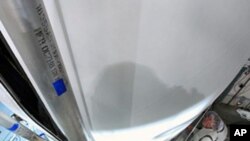NASA had to postpone Thursday's planned launch of twin solar-powered spacecraft to the moon because of upper level wind conditions, but the U.S. space agency now hopes to launch the GRAIL lunar mission from Cape Canaveral in Florida on Friday, September 9. Our reporter has more on the GRAIL mission to determine the structure of the lunar interior, from crust to core.
If you look at the moon with a telescope, it's clear that our nearest neighbor is not smooth and uniform, but marked by craters and mountains. NASA scientists say that there is even more variation beneath the lunar surface, and that our moon has the lumpiest gravitational field they know of in the solar system.
Ed Weiler, of NASA's Science Mission Directorate, explains the goal of the nearly $500 million GRAIL lunar mission.
"GRAIL, simply put, is a journey to the center of the moon," said Weiler. "It will probe the interior of the moon and map its gravity field 100 to 1,000 times better than ever before."
Weiler explains the twin, washing-machine sized crafts will essentially chase one another around the moon, about 200 kilometers apart, and use radio signals to determine the distance between them.
"As the first satellite goes over a higher mass concentration or higher gravity, it will speed up slightly, and that will increase the distance," he said. "And then as the second satellite goes over, that distance will close again."
In this tandem formation, the spacecraft will spend three months mapping the moon's gravitational field. NASA expects GRAIL to yield the most accurate gravity map of the moon to date.
Scientists will then compare gravitational and topographical maps of the lunar surface. They expect there to be a difference in the gravitational signal over lunar craters and mountains. If that is not the case, it will be a sign that something is going on in the moon's interior.
Also, just as the moon creates tides in our oceans, Earth's gravity creates tides in the solid moon - all the way down to its core. GRAIL will be able to map those changes, enabling scientists to deduce information about the moon's interior.
NASA says the insights gained from the GRAIL mission will help them better understand the way rocky planets, including Earth, formed. And the gravitational map will be an important navigational tool for future lunar spacecraft.
The GRAIL twins are scheduled to arrive at the moon around New Year's Day - January 1, 2012.
Moon facts, courtesy of NASA:













